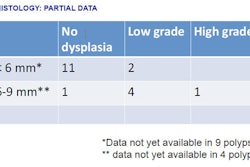Criteria based on CT imaging of changes in tumors from colorectal liver metastases after chemotherapy with bevacizumab may help predict overall survival, according to a study in the December 2 issue of JAMA (2009, Vol. 302:21, pp. 2338-2344).
Adding bevacizumab to cytotoxic chemotherapy is associated with improved survival in patients with stage IV colorectal cancer and higher pathologic response rates in patients undergoing surgical removal of colorectal liver metastases, according to lead author Dr. Yun Shin Chun, of the M. D. Anderson Cancer Center at the University of Texas in Houston.
"Recently, pathologic response to preoperative chemotherapy has been shown to correlate with improved survival and has been proposed as a new outcome end point after resection of colorectal liver metastases," the researchers wrote. "To date, a noninvasive method of predicting pathologic response to chemotherapy in colorectal liver metastases, particularly biologic agents, is lacking." It has been observed that after bevacizumab-containing therapy, colorectal liver metastases not only decrease in size, but also undergo unique morphologic changes on CT, they added.
Chun and colleagues conducted the study to validate tumor response criteria based on morphologic changes observed on CT in patients with colorectal liver metastases treated with bevacizumab-containing chemotherapy regimens. The group analyzed a total of 234 colorectal liver metastases from 50 patients who underwent hepatic resection after preoperative chemotherapy from 2004 to 2007; the date of last follow-up was March 2008.
All patients underwent routine contrast-enhanced CT at the beginning and end of preoperative therapy. Radiologists evaluated images for morphologic response, based on metastases changing from heterogeneous masses with ill-defined margins into homogeneous lesions with sharp borders. These criteria were validated with a separate group of 82 patients with unresectable colorectal liver metastases treated with bevacizumab-containing chemotherapy.
The researchers found that "morphologic criteria correlated strongly with the percentage of residual tumor cells and also with pathologic response stratified as complete, major, or minor using 50 percent residual tumor cells as the cutoff value between major and minor pathologic response. Optimal morphologic response to preoperative therapy translated into a survival benefit after hepatic resection. In a separate validation cohort of patients with unresectable colorectal liver metastases, response by morphologic criteria was also associated with improved overall survival."
The study results indicate that morphologic response may be a useful, noninvasive surrogate marker of pathologic response and improved survival in patients with colorectal liver metastases, according to the researchers. It provides complementary information to traditional size-based criteria in assessing CT response to bevacizumab in colorectal liver metastases, they wrote.
Related Reading
Perfusion CT predicts tumor response to antiangiogenic treatment, December 1, 2008
ROI changes colorectal tumor perfusion measurements, August 26, 2008
Copyright © 2009 AuntMinnie.com



















